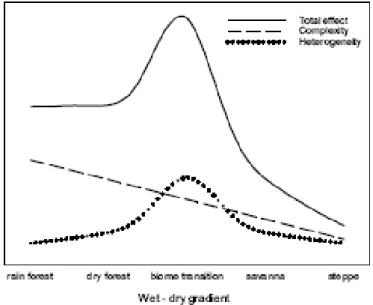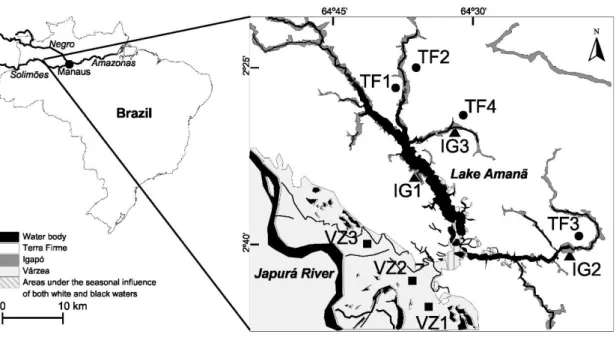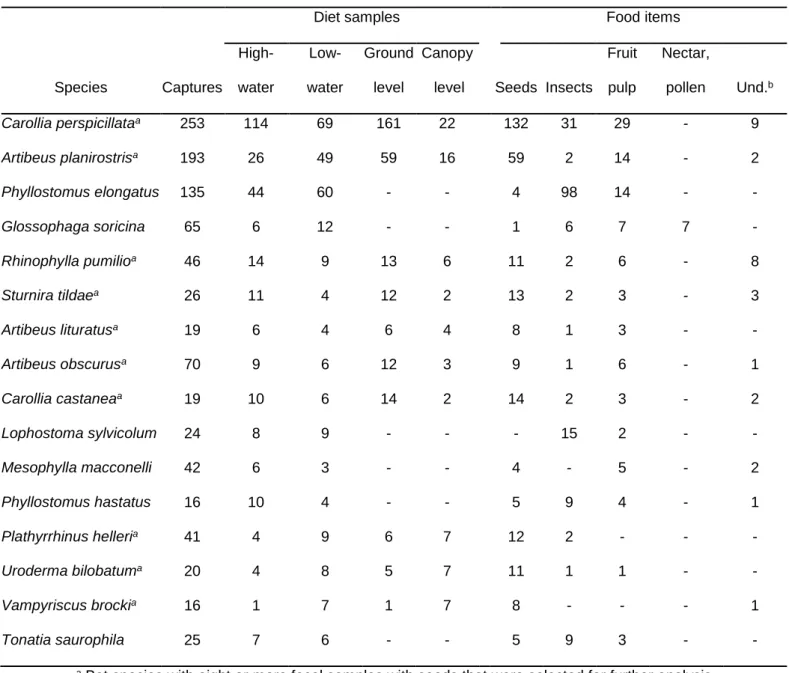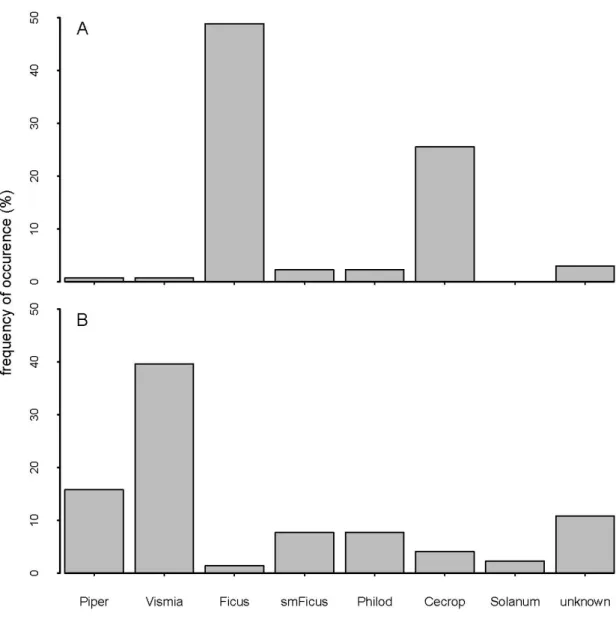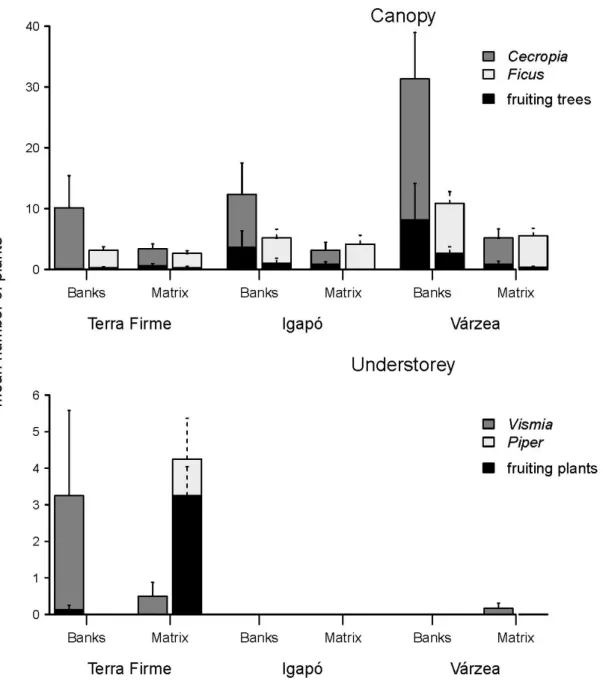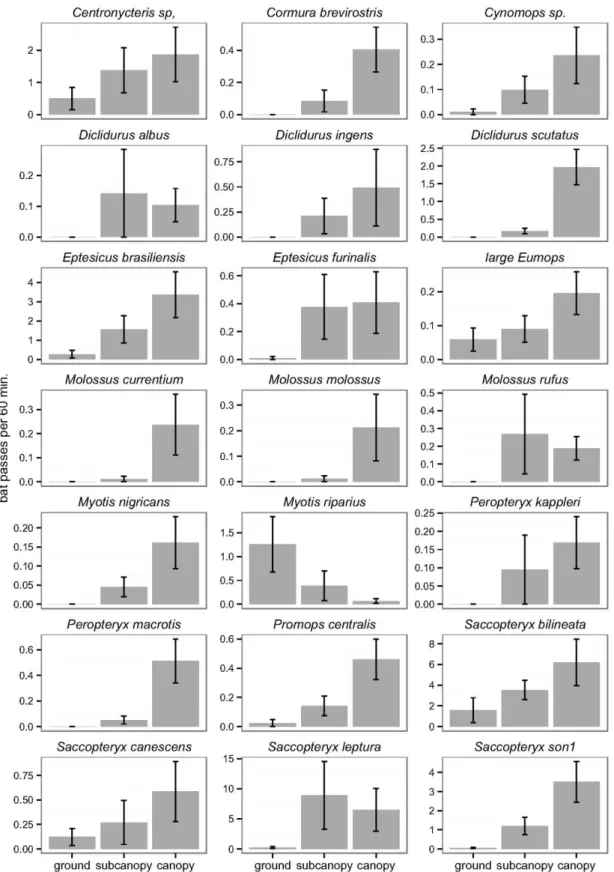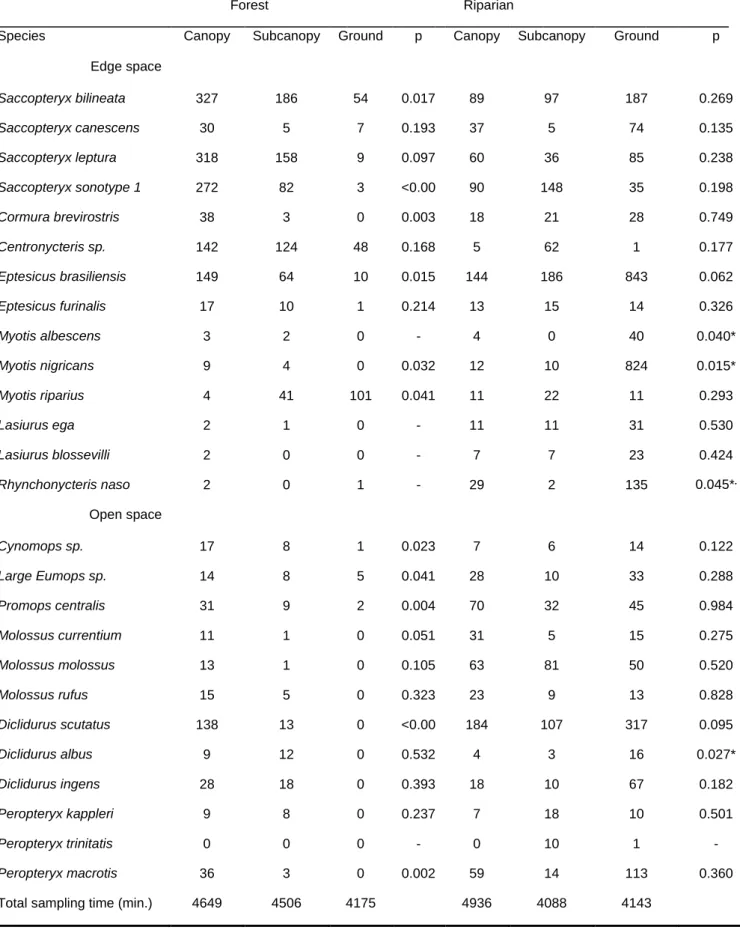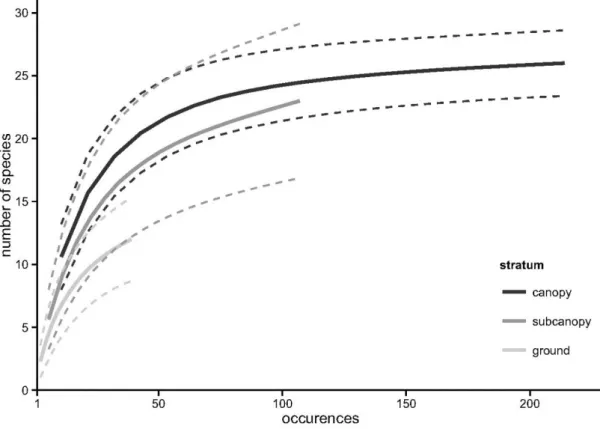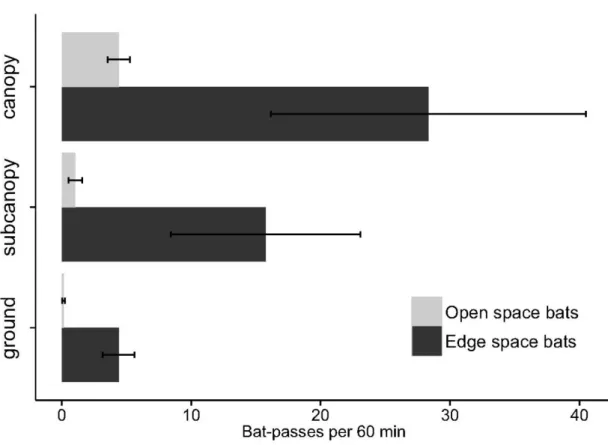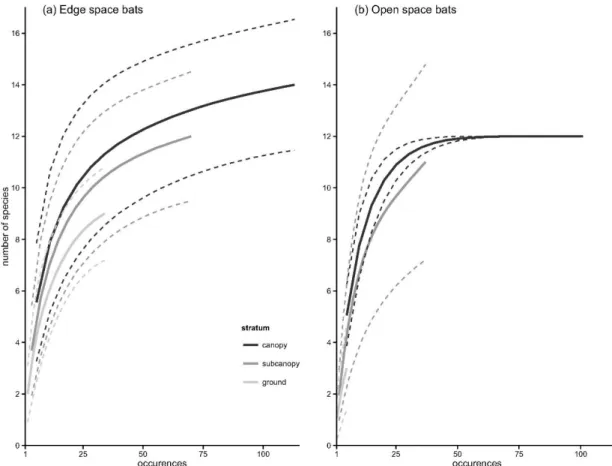2016
UNIVERSIDADE DE LISBOA FACULDADE DE CIÊNCIAS
Structuring Amazonian bat assemblages: importance of
horizontal and vertical dimensions of habitat
Doutoramento em Biologia
Especialidade de Ecologia
João Tiago Sabino Lino Marques
Tese orientada por:
Professor Doutor Jorge Manuel Mestre Marques Palmeirim
Structuring Amazonian bat assemblages: importance of
horizontal and vertical dimensions of habitat
Doutoramento em Biologia
Especialidade de Ecologia
João Tiago Sabino Lino Marques
Tese orientada por:
Professor Doutor Jorge Manuel Mestre Marques Palmeirim
Júri: Presidente:
● Doutora Maria Manuela Coelho Vogais:
● Doutor Christoph Friedrich Johannes Meyer ● Doutor Carlos Manuel Martins Santos Fonseca ● Doutor Jorge Manuel Mestre Marques Palmeirim
● Doutora Maria Margarida de Mello dos Santos-Reis Gutteres da Fonseca ● Doutora Ana Margarida Torres Rainho
Documento especialmente elaborado para a obtenção do grau de doutor Instituição Financiadora – FCT- Fundação para a Ciência e Tecnologia
iii
This study was funded by Fundação para a Ciência e a Tecnologia (FCT), through a PhD grant (SFRH/BD/22829/2005), the project POCI-PPCDT⁄BIA-BDE⁄ 60710 ⁄2004 and a Bat Conservation International Grant.
v Nota Prévia
A presente tese apresenta resultados de trabalhos já publicados ou em preparação para publicação (capítulos 2 a 5), de acordo com o previsto no nº 2 do artigo 25º do Regulamento de Estudos Pós-Graduados da Universidade de Lisboa, publicado no Diário da República II série nº 57 de 23 de março de 2015. Tendo os trabalhos sido realizados em colaboração, o candidato esclarece que participou integralmente na conceção dos trabalhos, obtenção dos dados, análise e discussão dos resultados, bem como na redação dos manuscritos.
Lisboa, março de 2016
vii
Para Neia, Carolina, Pedro e Joana
Aos meus pais, Amélia e João, e irmã, Helena
ix
To Jorge Palmeirim, my supervisor, for all the guidance and support. The work in the Amanã project was the adventure and opportunity of a lifetime. During our long talks about the Amazon and the ecological knowledge about the region I learned how to tell an important scientific story in a clear way.
To Maria João, who invited me to this adventure and was my companion in the beautiful forests of the Amanã. We shared friendship, hard work and stories. Thank you so much.
Many thanks go to Joana Santana and David Santos, the bird team of the research project. They shared with us their knowledge and discoveries of the other amazing group of flying vertebrates in the Amazon.
Pedro Santos and Jomber who were the pioneers in the idea of the study of the vertebrate fauna and its relation to the vegetation in the different types of the seasonally flooded and unflooded forests in the Amanã
The Instituto Mamirauá, for all the support from research facilities to the logistic and contacts in the local communities. Helder Queiroz, Miriam Marmontel, João Valsecchi and Eliano Ramalho had an important role in the support and planning of field work seasons. João and Eliano also joined the team when we visited the remote Centro Grande area.
The boat crews that worked with us for their invaluable help and tips on how to carry out field work and live in the Amazon. A special thanks goes to the Uacari crew (the captain Zé Penha, Sr. Otávio, Sr. Bento and Deuza) for making it our home.
x
Jerry Tavares dos Santos, our main field assistant, who guided us into the forests of the Amanã, assisted us in numerous tasks like setting nets in flooded habitats, mounting lines and ropes in the forest canopy, identifying and estimating fruits, finding our way to the nets in the middle of the night. He also taught us the sounds of the forest and their meaning, how to paddle a tiny canoe, how to keep the thousands of mosquitoes away, to set camp in a frorest, etc, etc. We will tell these stories to our grandchildren…
All the field assistants and people of the communities in the Amanã Sustainable Development Reserve for their generousity and helping us in the living and working in these forests
Elisabeth Kalko, who listened about our work with incredible enthusiasm and taught me that it is worth pursuing the light at the end of the tunnel, even if you are not seeing it.
Friends and colleagues at the Faculdade de Ciências da Universidade Lisboa, Ana Leal, Ana Rainho, Nuno Pedroso, Joaquim Pedro Ferreira, Luis Costa, Mafalda Basto, Luis Miguel Rosalino, Teresa Pedroso, Christoph Meyer, Ricardo Rocha for their support and friendship.
Two kisses to Sérgio Chozas for the road that we shared, that started so long ago and that will continue for long, long years.
Colleagues and students of the University of Évora for the warm welcome. In particular I would like to thank to Luis Gomes, Carlos Godinho and Ana Galantinho, with whom it is always a pleasure to discuss ecology and life in general.
Prof. António Mira was a great influence in my continuing studies and we developed a similar taste for the conservation of bats
xi
environment and supported the final stages of this thesis.
Sara Santos, Maria João Pereira, Ana Lumbreras and Luis Sousa kindly reviewed chapters of the thesis. However, I take full responsability for the mistakes that persisted in the document.
My sister, who is an inspiration to me, for her attention to detail and observation of animal behaviour and integration in nature conservation.
My parents, who always supported me and taught me that you can do whatever you want in life, even if it sounds very strange to them. My father, who is my example of love, hard work and honesty. My mother, for all the love and support.
My kids, Carolina, Pedro and Joana, who are so special and transformed my life. Carolina for kindly asking me how work was going and gave often her adult advice of how to end it quickly. Pedro for sharing the love and interest for animals and Joana, the sweet princess that thinks that bats are cute.
Neia, for all the support, companionship and love. Thank you for everything, our life and for our kids. I would not make it without your patience and encouragement.
The financial support for the development of this work is acknowledged to the Portuguese Fundação para a Ciência e a Tecnologia - FCT, for PhD grant SFRH/BD/22829/2005.
Part of this work was also supported by the FCT through the project POCI-PPCDT⁄BIA-BDE⁄ 60710 ⁄2004 and a Bat Conservation International Grant.
xiii
"Há outro rio chamado Maranhão, que desagua no Rio Tocatins,
como diremos em seu lugar; mas ainda que é grande e caudaloso,
é regato a respeito deste Maranhão; Orelhana ou Amazonas, que
pela sua grandeza, longitude, e muitas águas, se faz digno de ser
chamado um mar natante, o máximo e monarca dos rios, e
merecedor de muitos nomes e muitos títulos."
Padre Jesuíta João Daniel
xv Acknowlegements ... ix Abstract ... xvii Resumo ... xxi Chapter 1 ... 1 1 General Background ... 3
1.1 Thesis objectives and organization ... 10
1.2 References... 12
Chapter 2 ... 17
2 Availability of food for frugivorous bats in lowland Amazonia: the influence of flooding and of river banks ... 19
2.1 Abstract ... 19
2.2 Introduction ... 20
2.3 Materials and Methods ... 23
2.4 Results ... 27
2.5 Discussion... 35
2.6 Acknowledgements ... 44
2.7 References... 45
Chapter 3 ... 51
3 Patterns in the use of rainforest vertical space by Neotropical aerial insectivorous bats: all the action is up in the canopy ... 53
3.1 Abstract ... 53
3.2 Introduction ... 55
3.3 Materials and Methods ... 57
xvi 3.5 Discussion... 69 3.6 Acknowledgements ... 77 3.7 References... 78 Supporting Information... 83 Chapter 4 ... 87
4 Optimizing Sampling Design to Deal with Mist-net Avoidance in Amazonian Birds and Bats ... 89
4.1 Abstract ... 89
4.2 Introduction ... 91
4.3 Materials and methods ... 93
4.4 Results ... 97 4.5 Discussion... 103 4.6 Acknowledgements ... 109 4.7 References... 110 Chapter 5 ... 115 5 General discussion ... 117 5.1 Conservation implications ... 124
5.2 Final remarks and further research ... 126
xvii
Abstract
Environmental heterogeneity is one of the factors that underpins the species richness of an area. However, this important relationship has only been poorly documented in tropical regions or in low human impact areas due to the scant data. The overall objective of this thesis is to contribute to the understanding of how the spatial components of environmental heterogeneity, both horizontal and vertical, contribute to the high number of ecological niches that explain the high biodiversity of Amazonian rainforests. More specifically, this thesis attempts to unveil the relevance of different types of forests, river bank vegetation and forest vertical component to the ecological structure of the megadiverse bat fauna of Amazonia.
First, in Chapter 2 we focused on the horizontal component of environmental heterogeneity. In this paper we studied forest inundation and river banks as determinants of the spatial variation in the availability of fruits for bats in lowland Amazonia. We sampled the bat assemblage composition, fruit availability, and bat diet in terra firme upland forest and in two types of flooded forest - várzea and igapó. We grouped the bat species in two functional groups, the understorey and the canopy feeding guilds. We found that the várzea forests had abundant fruit resources for the canopy bats, while terra firme provided more fruits for the understorey bats. Additionally, river bank vegetation provided more fruit availability for bats, particularly for the canopy feeding guild on the edges of the várzea forests and for the understory feeding guild on the edges of the terra firme forests.
Moreover, bats showed high fidelity to their feeding guild; they consumed a high proportion of their preferred fruits - canopy or understory - even in forest types or areas where these fruits were scarce.
xviii
In conclusion, both the forest type and the river bank vegetation influence the availability of fruits, although differently for the canopy and understory guilds. The resulting differences in fruit abundance may explain variations in bat assemblages of the different forest types. River banks play a particularly important role in providing food for bats of both guilds. By increasing the niche space, the mosaic of forests may play an important role in supporting such a diverse bat assemblage.
The assessment of the contribution of the vertical component of environmental heterogeneity to the structuring of the Amazonian bat assemblage is presented in Chapter 3. Here, we studied the vertical space use of aerial insectivorous bats. Using automatic ultrasound recording stations placed in the canopy, subcanopy and understorey we tested if bat activity and species diversity are vertically stratified, both in the forest interior and near the edges of water bodies. These patterns were tested separately for 21 individual species, and for two functional groups - open space and edge space bats. Our results show that insectivorous bat activity increased by roughly seven fold, and species diversity doubled, from the understorey to the canopy. Both edge space and open space bats were more active in the upper strata, but this tendency was much more accentuated in the latter. Myotis riparius was the only species with greater activity near the understorey. These broad patterns were altered at the edges of water bodies, where vertical stratification was much less marked.
The observed patterns are parsimoniously explained by constraints imposed by vegetation clutter that change across strata, which affect bat species differently. Only bats better adapted to closed spaces are usually capable of foraging within the understorey, whereas the majority of species can exploit the free spaces immediately below the canopy; open space bats seem to concentrate their activity above the canopy. Our results underline the need to preserve pristine stratified rainforests. Moreover, the concentration of insectivorous bats at the upper strata of rainforests underlines the need to include canopy level sampling in ecological studies.
xix
the impact of mist net avoidance in bats and birds. We quantified the day-to-day decline in captures of Amazonian birds and bats with mist nets set at the same location for four consecutive days. We also evaluated how net avoidance influences the efficiency of surveys under different logistic scenarios by subsetting data. Our results demonstrated that net avoidance caused substantial declines in bird and bat captures, although more accentuated in the latter. Most of the decline occurred between the first and second days of netting: 28 % in birds and 47% in bats. Captures of commoner species were more affected and the numbers of species detected also declined. Moving nets daily to minimize the avoidance effect increased captures by 30% in birds and 70% in bats. However, moving the location of nets may cause a reduction in netting time and captures, and we further investigated the implications of that logistic constraint. When moving the nets caused the loss of one netting day it was no longer advantageous to move the nets frequently. In bird surveys that could even decrease the number of individuals captured and species detected.
Net avoidance can greatly affect sampling efficiency but adjustments in survey design can minimize this. Whenever nets can be moved without losing netting time and the objective is to capture many individuals, they should be moved daily. If the main objective is to survey species present then nets should still be moved for bats, but not for birds. However, if relocating nets causes a significant loss of netting time, moving them to reduce effects of shyness will not improve sampling efficiency in either group. Overall, our findings can improve the design of mist netting sampling strategies and can be applied in other tropical areas.
The novel information presented in this thesis and the conclusions indicate that both the horizontal and vertical components of habitat heterogeneity are very important to increase niche space. However, I propose to add a new spatial component, the habitat
xx
disruptions or discontinuities, to the horizontal and vertical components of environmental heterogeneity. This component, which integrates both the river bank vegetation and the free spaces between the vertical forest layers, has a similar relevance than the two components; it plays a significant role in the link between environmental heterogeneity and species richness.
Key-words: environmental heterogeneity, flooded and unflooded forests, river bank vegetation, vertical stratification, Amazonian bats
xxi
A diversidade de espécies animais está directamente relacionada com as características ambientais. Vários trabalhos de investigação têm focado este tema de investigação, mas existem poucos estudos em áreas tropicais e em regiões com muito baixo impacto humano. O objetivo geral desta tese é contribuir para o conhecimento de como os componentes espaciais da heterogeneidade ambiental, o componente horizontal e o vertical, contribuem para o elevado número de nichos ecológicos que explicam a elevada biodiversidade das florestas Amazónicas. Especificamente, será avaliada a relevância dos diferentes tipos de floresta, da vegetação ripícola e da estratificação vertical para a estruturação da fauna hiperdiversa de quirópteros da Amazónia.
No capítulo 2 são apresentados os resultados da investigação sobre a componente horizontal da heterogeneidade ambiental. Neste artigo foi estudado o efeito da inundação das florestas e da vegetação das margens dos cursos de água na variação espacial da disponibilidade de frutos para os morcegos nas florestas da bacia do Amazonas. Amostrámos a composição das espécies de morcegos, a disponibilidade de frutos e a dieta dos morcegos na floresta não inundável, terra firme, e em dois tipos de florestas inundáveis, a várzea e o igapó. Também foram amostrados locais de vegetação da margem de cursos de água na orla dos três tipos de florestas. As espécies de morcegos foram classificadas em dois grupos funcionais, os morcegos que se alimentam de frutos da copa e os que se alimentam de frutos presentes em arbustos e pequenas árvores no subcoberto. Os resultados indicam que as florestas de várzea têm maior abundância de recursos para os morcegos de copa, enquanto a terra firme tem maior disponibilidade de frutos para os morcegos que se alimentam no subcoberto. Ademais, os morcegos demonstraram uma elevada fidelidade ao seu grupo funcional; eles consumiram uma elevada proporção dos frutos
xxii
preferidos – de copa ou de subcoberto - mesmo nas áreas ou tipos de floresta em que estes são escassos. A vegetação de orla dos cursos de água apresentou maior disponibilidade de frutos de copa nas florestas de várzea e de frutos de subcoberto, nas florestas de terra firme.
Concluímos que ambos os fatores, o tipo de floresta e a vegetação ripícola influenciam a disponibilidade de frutos, embora de modo diferente para os grupos de morcegos que se alimentam de frutos de copa ou que se alimentam de frutos de subcoberto. Estas diferenças podem explicar as variações da ocorrência e abundância dos morcegos frugívoros nos diferentes tipos de floresta. A vegetação ripícola desempenha um papel muito importante na disponibilidade de alimento para os morcegos de copa nas áreas ribeirinhas de florestas de várzea e para os morcegos que se alimentam no sub-coberto nas áreas ribeirinhas de florestas de terra firme. O mosaico com florestas de terra firme, igapó e várzea aumenta o número de nichos ecológicos e pode desempenhar um papel importante no suporte a uma comunidade de morcegos com elevada diversidade.
A influência da componente vertical da heterogeneidade ambiental para a estruturação da comunidade de quirópteros Amazónica foi avaliada estudando o uso do espaço vertical por morcegos insectívoros que capturam os insetos em vôo (Capítulo 3). Utilizando estações de gravação automática de ultra-sons colocadas a diferentes alturas na floresta, na copa, na subcopa e no subcoberto, nós testámos se a atividade dos morcegos e a diversidade de espécies têm uma estratificação vertical, tanto em áreas de floresta como na orla de cursos de água e lagos. A existência destes padrões foi testada separadamente para as 21 espécies e para dois grupos funcionais – morcegos que caçam em espaços abertos e morcegos que caçam em orlas.
xxiii
recolhidos no sub-coberto. Tanto os morcegos que caçam em áreas abertas como os que caçam nas orlas estiveram mais activos nos estratos superiores, mas esta tendência foi muito mais acentuada nos últimos. A espécie Myotis riparius foi a única com maior atividade no estrato inferior. Estes padrões não foram observados nas margens dos corpos de água, onde a estratificação vertical é menos marcada.
Os padrões observados são explicados parcimoniosamente pelos constrangimentos impostos pela densidade de obstáculos da vegetação, que muda consoante os estratos, e que afecta as espécies de morcegos de modo diferente. Apenas os morcegos que estão melhor adaptados a voar em espaços fechados são capazes de procurar alimento no sub-coberto, enquanto a maioria das espécies se alimenta nos espaços livres debaixo da copa; os morcegos que voam nos espaços abertos concentram a sua atividade acima da copa da floresta. Os resultados sublinham a importância da preservação de florestas pristinas e com vegetação estratificada. Ademais, a concentração de morcegos insetívoros nos estratos superiores das florestas indica que devemos incluir a amostragem de copa nos estudos ecológicos.
O estudo das desvantagens e a otimização dos métodos de amostragem são tarefas importantes para os cientistas que as usam. No capítulo 4 são apresentados os resultados do impacto do comportamento de evitar as redes nos morcegos e nas aves. Este comportamento verifica-se quando os animais aprendem onde estão localizadas as redes de captura e começam a evitar-las. Neste artigo nós quantificámos a diminuição das capturas de morcegos e aves da Amazónia quando as redes japonesas ficam colocadas no mesmo local por quatro dias consecutivos. Também foi avaliado como o comporetamento de evitar as redes pelos animais influencia a eficiência das inventariações biológicas em diferentes cenários logísticos.
xxiv
O comportamento de evitar as redes causou diminuições substanciais nas capturas de aves e de morcegos, embora seja mais acentudada nos últimos. A maior parte do declínio ococrreu entre o primeiro e o segundo dia de amostragem: 28% nas aves e 47% nos morcegos. As capturas das espécies mais comuns foram que mais decairam e o número de espécies também diminuiu.
Mover as redes a cada dia para minimizar o comportamento de evitar as redes aumenta as capturas em 30% para as aves e em 70% para os morcegos. Contudo, ao mover as redes de local podemos gastar tempo de amostragem. Se quando movemos as redes perdemos um dia de amostragem pode não ser vantajoso mover as redes frequentemente. Nos trabalhos de inventariação de aves isso até pode reduzir o número de indivíduos capturados e de espécies detectadas. Nós testámos as implicações destes efeitos contrários considerando diferentes cenários logísticos para aconselhar que medidas tomar para diminuir o impacto deste comportamento nos inventários biológicos.
O comportamento de evitar as redes pode ter um grande impacto na eficiência de amostragem mas ajustes no desenho de amostragem podem minimizá-lo. Quando as redes podem ser movidas sem perda de tempo de amostragem e o objectivo é a captura do maior número de indivíduos, devemos muda-las diariamente. Se o objectivo é a detecção do maior número de espécies numa área então as redes devem ser deslocadas diariamente para os morcegos, mas não para as aves. Contudo, se a mudança das redes causa uma perda de tempo de captura, então a mudança de local das redes não melhora a eficiência de amostragem nos dois grupos. As nossas conclusões podem ajudar o planeamento de estratégias de amostragem com redes noutras florestas tropicais.
As informações recolhidas e conclusões que integram esta tese indicam a elevada importância da componente horizontal e vertical para a relação entre a
xxv
entre os estratos de vegetação vertical, é proposta a adição de um novo componente espacial, as descontinuidades do habitat. Este componente espacial tem uma importância semelhante ao componente horizontal e vertical na ligação entre a heterogeneidade ambiental e a riqueza de espécies.
Os resultados desta tese também apontam para a importância da conservação de florestas tropicais húmidas para a manutenção da elevada riqueza de espécies de morcegos. Estas florestas devem ser conservadas com a manutenção de mosaicos de diferentes tipos de floresta (terra firme, várzea e igapó), e com uma copa alta e bem preservada, mantendo os espaços livres por baixo da copa. Também é importante a preservação da vegetação de orla de cursos de água que interrompem as florestas Amazónicas, porque proporcionam recursos alimentares para morcegos frugívoros e áreas de alimentação com menor densidade de obstáculos para os morcegos insetívoros.
Palavras-chave: heterogeneidade ambiental, florestas inundáveis e terra firme, vegetação ripícola, estratificação vertical, morcegos da Amazónia
1
Chapter 1
3
Why there is this number of species in a habitat? What features make a region or a habitat able to host such a large or low number of species? These simple questions related to the conditions and drivers of the coexistence of species have been central issues in ecology (e. g. Hortal et al. 2009).
Environmental diversity, at multiple scales, is widely recognized as an important determinant of the number of species in ecosystems. Early work by Koopman (1958) stated the importance of “the element of ecological difference” influencing the total number of species inhabiting islands off the coast of South America. Later, Lack (1969) acknowledged that ecological constraints explain the small numbers of species on islands: islands with fewer habitats compared to nearest mainland area, i. e. “degree of ecological impoverishment”, hosted less species. And, in their influential work, MacArthur and Wilson (1967) concluded that environmental diversity exerts a more direct influence than area on the species numbers present on islands.
Numerous empirical and theoretical studies described and tested the relationship between environmental diversity and species numbers (reviewed in Tews et al. 2004, Hortal et al. 2009). Recently, a robust meta-analysis, integrating data from a very large number of published empirical studies (n=1148 data points), found substantial quantitative support for a strong positive relationship between environmental diversity and species numbers (Stein et al. 2014). The authors concluded that this relationship is widespread across the world, is present in many different taxa, and is evident across multiple spatial scales, from small patches within habitats (1m2 plots) to entire regions.
The mechanisms underlying the environmental heterogeneity-species diversity relationship can be divided into ecological and evolutionary categories (Stein and Kreft
1. General Background
4
2014), which can be further divided into three major groups acting at different time scales: ecological factors, species persistence promotion and speciation events. Ecological mechanisms have been recognized for long as a major underlying factor supporting the relationship between environmental heterogeneity and species richness diversity (Tews et al. 2004, Hortal et al. 2009, Brown 2014, Stein et al. 2014). The most common explanation is that environmental heterogeneity increases the number of habitats, the number and extent of environmental gradients, the availability of resources and the structural complexity, thus supporting an increase of niche space that enables more species to coexist (e. g. Tews et al. 2004). Therefore, heterogeneous habitats, landscapes or biomes provide more opportunities for species to coexist through more potential niches and diverse resources (Stein and Kreft 2014). Evolutionary mechanisms also play a role in the environmental heterogeneity-species diversity relationship, but on longer time scales; species experiencing adverse environmental conditions are more likely to persist in environmentally heterogeneous landscapes. Speciation events that result from the adaptation to different environmental conditions are also more likely to occur in areas with higher heterogeneity (Stein et al. 2014).
Environmental heterogeneity (EH) can be gauged using biotic and non-biotic measures with different degrees of success. In their comprehensive review, Stein et al. (2014) show that biotic measures of EH correlate with species richness better than non-biotic measures of EH such as climatic or soil variables. Moreover, among the most used biotic EH measures, plant diversity and vegetation complexity have the strongest correlation with animal species richness. They conclude that vegetation heterogeneity is a more direct driver of species richness, particularly for herbivores, because it provides a variety of food resources, shelter and roosting opportunities. Vegetation heterogeneity measures are also related to species richness of
non-5
herbivores because of their reliance on vegetation features that add structure to the habitats (Stein et al. 2014).
The overall positive EH-species diversity association (92.7% of statistically significant relationships) was present at several spatial scales, although the effect was stronger at smaller than at larger spatial scales (Stein et al. 2014). Surprisingly, the few negative EH and species diversity relationships also occurred mostly at small spatial scales. Confounding factors, such as fragmentation, may explain these outliers because they can be harder to account for at small spatial scales (Tews et al. 2004).
Despite of the remarkable number of empirical studies and meta-analyses on the relationship between species richness and EH, there are biases on the information collected. Most studies focus on vertebrate responses and, more importantly, take place on landscapes influenced by anthropogenic activity (Tews et al. 2004). As referred before, in such landscapes, environmental heterogeneity can even be confused with factors like fragmentation and habitat degradation (Tews et al. 2004). Therefore, there is a need for further empirical research on how EH relates to species richness in well-preserved landscapes, especially at small spatial scales.
At smaller spatial scales, such as habitats or within habitats, EH has two distinct dimensions: the horizontal component of variation (habitat heterogeneity) and the vertical component of variation (habitat complexity or vertical stratification) (sensu August 1983). Thus, throughout the text I employ the terms (Stein et al. 2014): (i) habitat diversity referring to the number of habitat types in a region, (ii) habitat heterogeneity for the horizontal variation within-habitat and (iii) habitat complexity to address within-habitat vertical variability, particularly its vertical stratification (August 1983, Hortal et al. 2009).
The contribution of the horizontal and vertical components of EH to overall species richness diversity, probably varies among biomes. Fahr and Kalko (2011)
1. General Background
6
recognized this and conceptualized a theoretical model of the influence of both components for the species diversity across a biome transect. According to their model, in rainforests habitat complexity (vertical component) has a higher contribution to species diversity than habitat heterogeneity (horizontal component) (Fig. 1). The authors base this model on the empirical observations that rainforest canopies consistently form a homogeneous habitat; across extensive rainforest regions, the dense canopy of rainforests is only interrupted by tree gaps and water courses. Although the model was put forward for West African forests, it seems to be adequate to the Amazonian rainforests. In fact, in the Amazon basin the numerous watercourses are the most prevalent interruption in the forest canopy. The riverbank vegetation present along many of these watercourses may thus represent a most important component of the horizontal heterogeneities in Amazonian rainforest (Junk and Piedade 2010). Moreover, within the large rainforest matrix, habitat complexity - the vertical structure of the vegetation - should play the most important role in increasing heterogeneity and the availability of ecological niches for species.
7
Tropical rainforests are the terrestrial biome that holds the highest species richness. It has been suggested that this incredible biodiversity is possible because the warm moist environment offers relatively benign abiotic conditions and abundant resources (Brown 2014). Almost half of the tropical rainforests are in the Neotropics, which also hold the world’s largest single block of rainforests: the Amazonian rainforest, covering basins of the Orinoco and the Amazon rivers and extending to the Guyanan shield (Corlett and Primack 2011). This extensive region holds an incredible biodiversity, and for several plant and animal groups, such as butterflies, birds and bats, this is the place on Earth where we can find the highest number of co-existing species (Corlett and Primack 2011).
In the Amazonian forests, bats make up a very high proportion of the vertebrate biomass; in some regions they constitute up to 60% of the mammalian fauna (Eisenberg 1990, Simmons and Voss 1998). Bat species richness in Amazonian sites often exceeds 70 species (Simmons and Voss 1998, Lim and Engstrom 2001, Bernard
Figure 1.1 Hypothetical model of the contribution of habitat structure on species richness along a biome gradient from rainforest to steppe. The contribution of habitat complexity, i. e. vertical component, on species richness is highest in rainforest (adapted from Fahr and Kalko 2011).
1. General Background
8
and Fenton 2002, Sampaio et al. 2003) and it is estimated that the Amazon basin hosts 117 bat species (Marinho-Filho and Sazima 1998).
Bats’ functional diversity also peaks in the Amazonian forests. They occupy as many as 10 feeding guilds (Kalko 1998), including some particularly well-known from this region, such as sanguivores and obligate piscivores. Both their impressive species richness and functional diversity contribute to the ecological importance of bats in the Amazonian forests. Throughout the Neotropical region they play very important ecological roles as plant-pollinators (Bawa 1990), seed dispersers over large distances and across open habitats (Muscarella and Fleming 2007), and controllers of insect herbivory (Kalka et al. 2008, Williams-Guillén et al. 2008).
Bats’ flight capacity enables them to explore rainforest niches that other vertebrates cannot reach, potentially taking full advantage of the niche spaces created by both habitat heterogeneity and complexity (sensu August 1983). They can easily travel to and forage in habitats and patches located several kilometers across the landscape (Morrison 1978, Ramos Pereira et al. 2009, Bobrowiec et al. 2014). Bats can also exploit several forest height strata, from ground level to over the forest canopy (Bernard 2001, Kalko and Handley 2001, Ramos Pereira et al. 2010).
Amazonian bats and birds share characteristics that are important determinants of their use of ecological space. Both groups are very speciose and have the ability to fly, which allows them to exploit extensive areas of habitat. Because of these similarities various studies compared the organization of both assemblages, their ecological needs and foraging ecologies (e. g. Palmeirim et al. 1989, Kalko 1998). These studies often use similar techniques to study bats and birds in rainforests, particularly when data collection requires capturing individuals. Mist-netting is one of the essential techniques to study the diverse assemblages of both Neotropical bats and birds. It is one of the most widely used techniques to capture and collect data for
9
biodiversity and auto-ecological studies for these two groups of flying vertebrates (Beja et al. 2010, Blake and Loiselle 2009, Ramos Pereira et al. 2009, Meyer et al. 2011, Bobrowiec et al. 2014). However, there is an increasing demand for empirical studies and fieldwork to be cost-effective and for that reason we need to assess the efficiency of the research tools and techniques that we use for collecting and analyzing data (Gardner et al. 2008, Meyer et al. 2015). Consequently, studies to optimize sampling methods in rainforests can make an important contribution to the advancement of knowledge of these ecosystems.
Despite the similarities in morphology of bats and birds there are also important ecological and functional differences in the Neotropics. Kalko (1998) reports 12 feeding guilds exclusive of birds and two feeding guilds exclusive of bats, although one third of the total guilds analysed were common to the two taxa. Bats and birds also differ in their response to land use change such as habitat fragmentation or degradation (Barlow et al. 2007). Neotropical bats respond to fragmentation in an idiosyncratic way, whereas birds behave as expected in a gradient of rainforest degradation. Bat species richness is higher in primary forests, but similar in secondary and plantation forests; bird species richness decreases monotonically from primary forests, to secondary forests and to plantations (Barlow et al. 2007).
Bats have very high energy demands because flying is costly (Kurta et al. 1989); birds have comparatively lower flight energy demands, because of their greater aerodynamic efficiency (Muijres et al. 2012). To meet these high energy needs bats need to find quickly and to forage in the most productive feeding areas, whether within habitats or across different habitats. Thus, the specific question “Where do bats forage?” is one of the most interesting and prevailing questions in the ecology of this group coupled with “What are the constraints or features of an area that is good bat foraging ground?”
1. General Background
10
1.1 Thesis objectives and organization
The overall objective of this thesis is to contribute to the understanding of how the vertical and horizontal components of habitat structure contribute to the high number of ecological niches that explain the tremendous biodiversity of Amazonian rainforests. More specifically, the thesis attempts to unveil the relevance of different types of forests, riverbank vegetation and forest vertical component to the ecology of the megadiverse bat fauna of Amazonia.
This thesis is structured in two main sections; the first analyses how both horizontal and vertical heterogeneity influence the structure of bat assembles in Amazonia, while the second contributes to the optimization of sampling of assemblages of flying vertebrates
The first section includes the results of two papers (Chapters 2 and 3). First, we investigated the contribution of horizontal environmental heterogeneity for species richness of fruit eating bats. To do that, I assessed the availability of fruits in seasonally flooded and unflooded forests – different habitats - and compared fruit availability between matrix forests with riverbank vegetation – habitat discontinuities.
Second, we investigated how bats fly and forage across the vertical strata of Amazonian forests. Specifically, we assessed how aerial insectivorous bats use the different height strata in the rainforests and how this use is altered by riverbank vegetation, which constitutes the most prevalent disruption of the dominant vertical stratification of these forests.
11
In the second section (Chapter 4) I present a third paper dealing with the limitations of mist-netting to collect data for auto-ecological and biodiversity field studies in Neotropical rainforest. Specifically, we assessed how net avoidance influences the number of captures of bats and birds and evaluate its impact on species richness estimates. The analyses for the two groups of flying vertebrates provide a comprehensive evaluation of the effect of this common response-behaviour to a widely used data collection technique.
1. General Background
12
1.2 References
August, P. V. 1983. The role of habitat complexity and heterogeneity in structuring tropical mammal communities. Ecology. 64: 1495–1507.
Barlow, J., T. A. Gardner, I. S. Araujo, T. C. Avila-Pires, A. B. Bonaldo, J. E. Costa, M. C. Esposito, L. V Ferreira, J. Hawes, M. I. M. Hernandez, M. S. Hoogmoed, R. N. Leite, N. F. Lo-Man-Hung, J. R. Malcolm, M. B. Martins, L. a M. Mestre, R. Miranda-Santos, A. L. Nunes-Gutjahr, W. L. Overal, L. Parry, S. L. Peters, M. A. Ribeiro-Junior, M. N. F. da Silva, C. da Silva Motta, and C. A. Peres. 2007. Quantifying the biodiversity value of tropical primary, secondary, and plantation forests. Proceedings of the National Academy of Sciences of the United States of America. 104: 18555–18560.
Bawa, K. S. 1990. Plant-polinator interactions in tropical rain forests. Annual Review of Ecology and Systematics. 21: 399–422.
Beja, P., C. Santos, J. Santana, M. J. Pereira, J. T. Marques, H. L. Queiroz, and J. M. Palmeirim. 2010. Seasonal patterns of spatial variation in understory bird assemblages across a mosaic of flooded and unflooded Amazonian forests. Biodiversity and Conservation. 19: 129–152.
Bernard, E. 2001. Vertical stratification of bat communities in primary forests of Central Amazon, Brazil. Journal of Tropical Ecology. 17: 115–126.
Bernard, E., and M. B. Fenton. 2002. Species diversity of bats (Mammalia: Chiroptera) in forest fragments, primary forests, and savannas in central Amazonia, Brazil. Canadian Journal of Zoology. 80: 1124–1140.
Blake, J. G., and B. A. Loiselle. 2009. Species composition of Neotropical understory bird communities: local versus regional perspectives based on capture data. Biotropica. 41: 85–94.
Bobrowiec, P. E. D., L. D. S. Rosa, J. Gazarini, and T. Haugaasen. 2014. Phyllostomid bat assemblage structure in Amazonian flooded and unflooded forests. Biotropica. 46: 312–321.
Brown, J. H. 2014. Why are there so many species in the tropics? Journal of Biogeography. 41: 8–22.
Corlett, R. T., and R. B. Primack. 2011. Tropical Rain Forests: an ecological and biogeografical comparison, Second Edi. ed. Wiley-Blackwell, Oxford, UK.
Eisenberg, J. F. 1990. Neotropical mammal communities, pp. 358–368. In Gentry, A.H. (ed.), Four Neotropical Rainforests. Yale University Press, New Haven and London.
13
Fahr, J., and E. K. V. Kalko. 2011. Biome transitions as centres of diversity: habitat heterogeneity and diversity patterns of West African bat assemblages across spatial scales. Ecography. 34: 177–195.
Gardner, T. A., J. Barlow, I. S. Araujo, T. C. Avila-Pires, A. B. Bonaldo, J. E. Costa, M. C. Esposito, L. V Ferreira, J. Hawes, M. I. M. Hernandez, M. S. Hoogmoed, R. N. Leite, N. F. Lo-Man-Hung, J. R. Malcolm, M. B. Martins, L. a M. Mestre, R. Miranda-Santos, W. L. Overal, L. Parry, S. L. Peters, M. A. Ribeiro-Junior, M. N. F. da Silva, C. da Silva Motta, and C. A. Peres. 2008. The cost-effectiveness of biodiversity surveys in tropical forests. Ecology Letters. 11: 139–50.
Hortal, J., K. A. Triantis, S. Meiri, E. Thébault, and S. Sfenthourakis. 2009. Island species richness increases with habitat diversity. The American Naturalist. 174: E205–217.
Junk, W. J., and M. T. F. Piedade. 2010. An Introduction to South American Wetland Forests: distribution, definitions and general characterization, pp. 3–25. In Junk, W.J., Piedade, M.T.F., Wittmann, F., Schongart, J., Parolin, P. (eds.), Amazonian Floodplain Forests. Ecophysiology, Biodiversity and Sustainable Management. Springer, Dordrecht.
Kalka, M. B., A. R. Smith, and E. K. V Kalko. 2008. Bats limit arthropods and herbivory in a tropical forest. Science. 320: 71.
Kalko, E. 1998. Organisation and diversity of tropical bat communities through space and time. Zoology. 101: 281–297.
Kalko, E., and C. Handley. 2001. Neotropical bats in the canopy: diversity, community structure, and implications for conservation. Plant Ecology. 153: 319–333.
Koopman, K. F. 1958. Land bridges and ecology in bat distribution on islands off the northern coast of South America. Evolution. 12: 429–439.
Kurta, A., G. P. Bell, K. A. Nagy, and T. H. Kunz. 1989. Energetics of pregnancy and lactation in free-ranging Little Brown Bats (Myotis lucifugus). Physiological Zoology. 62: 804–818.
Lack, D. 1969. The numbers of bird species on islands. Bird Study. 16: 193–209. Lim, B. K., and M. D. Engstrom. 2001. Species diversity of bats (Mammalia:
Chiroptera) in Iwokrama Forest, Guyana, and the Guianan subregion: implications for conservation. Biodiversity and Conservation. 10: 613–657.
MacArthur, R. H., and E. O. Wilson. 1967. The Theory of Island Biogeography, 1st ed. Princeton University Press, New Jersey.
Marinho-Filho, J. M., and I. Sazima. 1998. Brazilian bats and conservation biology: a first survey, pp. 282–294. In Kunz, T.H., Racey, P.A. (eds.), Bat Biology and Conservation. Smithsonian Institution Press, Washington, DC.
Meyer, C. F. J., L. M. S. Aguiar, L. F. Aguirre, J. Baumgarten, F. M. Clarke, J.-F. Cosson, S. E. Villegas, J. Fahr, D. Faria, N. Furey, M. Henry, R. Hodgkison, R. K.
1. General Background
14
B. Jenkins, K. G. Jung, T. Kingston, T. H. Kunz, M. C. MacSwiney Gonzalez, I. Moya, B. D. Patterson, J.-M. Pons, P. A. Racey, K. Rex, E. M. Sampaio, S. Solari, K. E. Stoner, C. C. Voigt, D. von Staden, C. D. Weise, and E. K. V. Kalko. 2011. Accounting for detectability improves estimates of species richness in tropical bat surveys. Journal of Applied Ecology. 48: 777–787.
Meyer, C. F. J., L. M. S. Aguiar, L. F. Aguirre, J. Baumgarten, F. M. Clarke, J.-F. Cosson, S. E. Villegas, J. Fahr, D. Faria, N. Furey, M. Henry, R. K. B. Jenkins, T. H. Kunz, M. Cristina MacSwiney Gonzalez, I. Moya, J.-M. Pons, P. a Racey, K. Rex, E. M. Sampaio, K. E. Stoner, C. C. Voigt, D. von Staden, C. D. Weise, and E. K. V Kalko. 2015. Species undersampling in tropical bat surveys: effects on emerging biodiversity patterns. Journal of Animal Ecology. 84: 113–123.
Morrison, D. W. 1978. Influence of habitat on the foraging distances of the Fruit Bat, Artibeus jamaicensis. Journal of Mammalogy. 59: 622–624.
Muijres, F. T., L. C. Johansson, M. S. Bowlin, Y. Winter, and A. Hedenström. 2012. Comparing aerodynamic efficiency in birds and bats suggests better flight performance in birds. PloS one. 7: e37335.
Muscarella, R., and T. H. Fleming. 2007. The role of frugivorous bats in tropical forest succession. Biological Reviews of the Cambridge Philosophical Society. 82: 573– 590.
Palmeirim, J. M., D. L. Gorchov, and S. Stoleson. 1989. Trophic structure of a Neotropical frugivore community: is there competition between birds and bats? Oecologia. 79: 403–11.
Ramos Pereira, M. J., J. T. Marques, and J. M. Palmeirim. 2010. Vertical stratification of bat assemblages in flooded and unflooded Amazonian forests. Current Zoology. 56: 469–478.
Ramos Pereira, M. J., J. T. Marques, J. Santana, C. D. Santos, J. Valsecchi, H. L. de Queiroz, P. Beja, and J. M. Palmeirim. 2009. Structuring of Amazonian bat assemblages: the roles of flooding patterns and floodwater nutrient load. Journal of Animal Ecology. 78: 1163–1171.
Sampaio, E. M., E. K. V Kalko, E. Bernard, B. Rodríguez-Herrera, and C. O. Handley Jr. 2003. A biodiversity assessment of bats (Chiroptera) in a tropical lowland rainforest of Central Amazonia, including methodological and conservation considerations. Studies on Neotropical Fauna and Environment. 38: 17–31.
Simmons, N. B., and R. S. Voss. 1998. The Mammals of Paracou, French Guiana: a Neotropical lowland rainforest fauna: Part 1. Bats. Bulletin of the American Museum of Natural History. 237: 1–219.
Stein, A., K. Gerstner, and H. Kreft. 2014. Environmental heterogeneity as a universal driver of species richness across taxa, biomes and spatial scales. Ecology letters. 17: 866–880.
15
Stein, A., and H. Kreft. 2014. Terminology and quantification of environmental heterogeneity in species-richness research. Biological reviews of the Cambridge Philosophical Society. 90: 815-936.
Tews, J., U. Brose, V. Grimm, K. Tielborger, M. C. Wichmann, M. Schwager, and F. Jeltsch. 2004. Animal species diversity driven by habitat heterogeneity/diversity: the importance of keystone structures. Journal of Biogeography. 31: 79–92.
Williams-Guillén, K., I. Perfecto, and J. Vandermeer. 2008. Bats limit insects in a Neotropical agroforestry system. Science. 320: 70.
17
Chapter 2
Availability of food for frugivorous bats in
lowland Amazonia: the influence of flooding and
of river banks
19
banks
2.1 Abstract
In Neotropical forests fruits are key resources for a great diversity of vertebrates, including many frugivorous bats, but little is known about the factors that determine their availability. We studied forest inundation and river banks as determinants of the spatial variation in the availability of fruits for bats in lowland Amazonia. We sampled the bat assemblage composition, fruit availability, and bat diet in terra firme upland forest and in two types of flooded forest - várzea and igapó. Two distinct frugivore bat guilds were found in both terra firme and flooded forests: (1) canopy frugivores, feeding mainly on Ficus and Cecropia, and (2) understorey frugivores that feed mainly on Vismia and Piper. Fruits consumed by the canopy guild were more abundant in the flooded forests - particularly in the nutrient-rich várzea, but those dominating the understory guild diet were most abundant in terra firme. Availability of both fruit genera most consumed by the canopy guild was greater along river banks than in the forest matrix. For the understory guild, the greater abundance of Vismia along river banks was compensated for by a higher availability of Piper in the matrix. In conclusion, both factors influence the availability of fruits, although differently for the canopy and understory guilds. The resulting differences in fruit abundance may explain variations in bat assemblages of the different forest types. River banks play a particularly important role in providing food for bats of both guilds, but are under particularly heavy human pressure.
2. Fruit availability for Amazonian frugivorous bats
20
2.2 Introduction
Most trees and shrubs of tropical rainforests produce fleshy fruits (Jordano, 2000), which are important and abundant food resources consumed by a diverse array of vertebrates; in some Neotropical forests the bulk of the bird and mammal biomass is supported by fleshy fruits (Fleming et al., 1987).
Bats constitute up to 60% of the Amazonian mammalian fauna, dominating the community in diversity and biomass (Simmons and Voss, 1998), and playing essential ecological functions. Frugivorous bats are particularly abundant in these Neotropical forests, where they are key seed dispersers of many plants that produce fleshy fruits (Giannini and Kalko, 2004; Lopez and Vaughan, 2004) and have an important role in forest regeneration and succession (Muscarella and Fleming, 2007; Willig et al., 2007).
Bats have high energetic requirements because flight is very costly (Kurta et al., 1989) and they have high metabolism, particularly in the case of frugivorous species (McNab, 1986). As the nutritional value of fruits tends to be low (Wendeln et al., 2000), bats need to eat large amounts of food to satisfy these high requirements (Morrison, 1978). Flight facilitates the fulfilment of these requirements, as it allows the selection of high quality feeding areas (Law, 1995) and, in fact, foraging frugivorous bats tend to be most active in the most productive habitats and sites (Willig et al., 2007; Ramos Pereira et al., 2009; Vargas-Contreras et al., 2009). Consequently, like for nectarivorous (Lemke, 1984) and insectivorous bats (Wang et al., 2010), the quality of foraging patches may be one of the main factors driving foraging decisions of frugivorous bats.
In the lowlands of Central Amazon, frugivorous bats seem to make a distinct use of different existing forest types (Ramos Pereira et al., 2009). Most of this vast
21
region is covered by terra firme forests that never flood, which are nutrient-poor because they have long been deprived of alluvial sediments (Irion et al., 1997). However, approximately 10% of the region is dominated by two forest types that are flooded for much of the year: the nutrient-rich várzea, seasonally flooded by “white-waters” loaded with sediments from the ice-melt and steep slopes of the Andes, and the oligotrophic igapó, seasonally flooded by nutrient-poor “black-water”, stained by organic compounds and originating in the forest plains (Prance, 1979; Ayres, 1993).
Amazonian forests have a mostly continuous and dense canopy layer, but along water courses this layer is interrupted, allowing abundant light to reach the ground (Bongers et al., 2001). This availability of light along the river banks and the proximity of water are likely to influence both the floristic composition of the forest and the fruiting phenology and productivity of its trees and shrubs (van Schaik et al., 1993). Along river margins these plants face less competition for solar radiation than inside the forest (Bongers et al., 2001), allowing them to allocate more energy to flower and fruit production (van Schaik et al., 1993). Consequently, it is likely that plants in river banks provide resource-rich patches to frugivores, including bats. Moreover, the distinct floristic composition of river bank forest (e. g. Salo et al., 1986) may diversify foraging opportunities for a variety of bat foraging guilds.
In lowland Amazonia, another factor potentially increasing fruit availability along river banks is their frequent natural disturbance due to lateral river erosion, and the subsequent formation of sediment beaches (Salo et al., 1986; Peixoto et al., 2009). These newly exposed soil and beaches are areas of primary succession (Parolin et al., 2002; Myster, 2009), and many frugivorous bats may exploit the abundant fruit resources provided by some pioneer and early-successional plants that become established in them, such as Cecropia, Piper and Solanum (Fleming, 1988; Palmeirim et al., 1989; Bernard, 2002; Aguiar and Marinho Filho, 2007).
2. Fruit availability for Amazonian frugivorous bats
22
This evidence suggests that in Neotropical rainforests vegetation along river banks may play a disproportionally important role in the provision of food resources for its rich fauna of frugivorous vertebrates, but to our knowledge this possibility has never been evaluated. There is also very little information about the relative availability of fruit in the different types of flooded and unflooded forests present in the central Amazonian floodplain, as only one paper presents data on this topic (Haugaasen and Peres, 2007).
In this study we assessed the potential value of river bank vegetation as foraging habitat for the diverse guild of Amazonian frugivorous bats, in lowland landscapes with flooded and unflooded forests. Our specific objectives were: (1) to study the feeding guild structure of an assemblage of frugivorous bats in a region dominated by a mosaic of terra firme, várzea, and igapó forests; (2) to identify differences in food availability in the three types of forest; and (3) to determine the potential importance of the vegetation along river banks to provide food for frugivorous bats.
23
2.3 Materials and Methods
Study Area
Field work took place in the Amanã Sustainable Development Reserve (ASDR, Amazonas, Brazil), a reserve covering 2 350 000 ha that contains nutrient-rich várzea forests and nutrient-poor igapó forests, within a matrix of terra firme forests (Figure 2.1).
Figure 2.1 Location of sampling sites (TF – terra firme, VZ – várzea, IG – igapó). The southern part of the lake usually has black water but can temporarily receive white waters. Distribution of habitats based on cartography by the Mamirauá Sustainable Development Institute and satellite imagery.
Lake Amanã (2º37’S, 64º37’W) is a mostly black-water lake fed predominantly by streams draining catchments dominated by terra firme. Igapó occurs mainly along the streams and margins of Lake Amanã, while most várzea is located in the floodplain of River Japurá. Human population density is very low and only ca 4000 people live
2. Fruit availability for Amazonian frugivorous bats
24
inside the reserve. The area receives about 2500 mm of annual precipitation, mostly during the high-water season, from January to June. The low-water season usually extends from July to December. Water levels vary up to 10 meters between the two seasons. Flowering and fruiting peaks usually occur in the low and high-water seasons, respectively (Ayres 1993). The dominant trees belong to the families Sapotaceae, Lecythidaceae, Euphorbiaceae, Myristicaceae and Leguminosae (Ayres 1993; Ramos Pereira et al. 2010a). Canopy height is usually between 15 and 35 m, with emergent trees reaching at least 50 m (Ayres 1993).
Bat and diet sampling ´
Bats were captured between April and June 2007, when várzea and igapó forests are flooded, and between October and December 2007, when all forests are dry. We sampled ten stations, of which four were in terra firme, three in várzea, and three in igapó. Each station was sampled during four consecutive nights using three 3 x 12 m mist nets set at canopy level (17-35 m high) and ten 12 x 3 m nets at ground level. During the high-water season ground mist nets were set above water in both várzea and igapó, but canopy nets were not used in these habitats because of logistical difficulties. The nets remained open between 18:00 and 24:00 h, because most bats tend to be captured in the early evening, and were checked every 20 minutes. Each captured bat was sexed, weighed, and identified using identification keys (Lim and Engstrom, 2001; Sampaio, Kalko and Wilson, personal communication). We made temporary marks on the patagium of bats using a pen marker, to allow recognition of recaptures over the same four day sampling period. However, there were only four recaptures and these were not included in the analyses.
25
The diet of the captured bats was studied by analyzing items found in feces. We kept each bat in a separate cotton bag for about 30 minutes to collect feces. These were then air dried and, using a stereo microscope, their contents were separated in five categories: seeds, fruit pulp, arthropods, pollen and flower parts, and undetermined. Seeds were identified using a reference collection from the site. It is worth noting that the medium- and large-sized frugivorous bats included in our analysis may consume forest fruits that were not recorded because the seeds are not ingested (e. g. Sapotaceae, Humiriaceae, Chrysobalanaceae, Araceae - see Lobova et al., 2009).
Fruit availability
In each of the ten sampling stations we used two 1km long fruit availability transects. One of the transects was located in the forest interior, partly coinciding with the location of the mist-nets, while the other was located along the nearest river bank. We identified all trees with canopies intersecting the transect line. Using binoculars and with the help of a local field assistant with extensive experience in the collection of plant phenology data, we determined which of those trees had ripe fruits. We also identified all fruiting shrubs within 2 meters of the transect line. The results of this method are approximate but since we used the same methodology and observer at all sites, we consider them suitable for the comparisons that we made. We estimated fruiting tree abundance in both high-water and low-water seasons, coinciding with the periods of bat captures. We present results on the availability of the main fruit genera consumed by the different bat foraging guilds. We also estimated the numbers of ripe fruits on trees and shrubs. However, the huge variability in numbers of fruits, especially because of figs, rendered these data unsuitable for the comparisons.
2. Fruit availability for Amazonian frugivorous bats
26
Data Analysis
The importance of each fruit type in the bats’ diet was quantified using the frequency of occurrence, i. e. the percentage of samples containing seeds of that fruit. Diet data were pooled by plant genus because we were often unable to identify the fruit remains to the species level. Only bat species with a minimum of eight diet samples containing seeds were included in the diet data matrix. This matrix was explored for the presence of feeding guilds by visually searching for clusters of species and fruits in the plot of the first two axes of a Correspondence Analysis implemented with PAST (version 1.90, Hammer et al., 2001).
Differences in fruit production between the three forest types and between the forest matrix and river bank vegetation were evaluated using the numbers of fruiting plants. Prior to statistical analyses the variables were log-transformed to approximate normality and reduce the influence of extreme values (Zuur et al., 2007). We used two-way repeated measures ANOVA to assess differences between the three forest types and transect location (forest matrix vs. river bank). This method accounts for the lack of independence (i. e. pseudoreplication, Hurlbert, 1984) caused by estimating fruit availability on the same transects during both seasons. ANOVA tests and Tukey HSD were done in R (version 2.10.1). The threshold for statistical significance was P≤ 0.05, although we also report and discuss near significant probability values, i. e. P<0.1.
27
2.4 Results
During the 80 nights of mist-netting we captured 1242 bats of 60 species, and collected a total of 599 diet samples from 32 bat species (305 in the high-water season and 294 in the low-water). Frugivore species represented 69.5% of the total of diet samples, and the best represented species were the frugivorous Carollia perspicillata and the omnivorous Phyllostomus elongatus (Table 2.1).
Diet and Feeding guild identification
Ten frugivorous bat species were included in the diet matrix, using a total of 199 diet samples for the high-water season and 171 samples for the low-water (Table 2.1).
2. Fruit availability for Amazonian frugivorous bats
28
Table 2.1 Numbers of bat captures and diet samples, and frequency of food items on fecal samples of bat species captured more than 15 times.
Diet samples Food items
Species Captures High- water Low- water Ground level Canopy
level Seeds Insects Fruit pulp Nectar, pollen Und.b Carollia perspicillataa 253 114 69 161 22 132 31 29 - 9 Artibeus planirostrisa 193 26 49 59 16 59 2 14 - 2 Phyllostomus elongatus 135 44 60 - - 4 98 14 - - Glossophaga soricina 65 6 12 - - 1 6 7 7 - Rhinophylla pumilioa 46 14 9 13 6 11 2 6 - 8 Sturnira tildaea 26 11 4 12 2 13 2 3 - 3 Artibeus lituratusa 19 6 4 6 4 8 1 3 - - Artibeus obscurusa 70 9 6 12 3 9 1 6 - 1 Carollia castaneaa 19 10 6 14 2 14 2 3 - 2 Lophostoma sylvicolum 24 8 9 - - - 15 2 - - Mesophylla macconelli 42 6 3 - - 4 - 5 - 2 Phyllostomus hastatus 16 10 4 - - 5 9 4 - 1 Plathyrrhinus helleria 41 4 9 6 7 12 2 - - - Uroderma bilobatuma 20 4 8 5 7 11 1 1 - - Vampyriscus brockia 16 1 7 1 7 8 - - - 1 Tonatia saurophila 25 7 6 - - 5 9 3 - -
a Bat species with eight or more fecal samples with seeds that were selected for further analysis
(see Methods). b Undetermined.
The correspondence analysis of the diet matrix revealed a clear structure relating frugivorous bats and the plant genera they consume. Bats that fed on fruits in the canopy were clearly separated from those that usually forage in the forest understorey along the first axis (Figure 2.2), which had an eigenvalue of 0.68, indicating a good separation of the species along that axis. The “canopy guild”, included bats that consumed almost exclusively Ficus and Cecropia fruits - Platyrrhinus
29
helleri, Vampyriscus brocki, Uroderma bilobatum, Artibeus planirostris, Artibeus lituratus and Artibeus obscurus. The “understorey guild”, included Rhinophylla pumilio, Carollia castanea, Sturnira tildae, and C. perspicillata, which fed mostly on understorey plants, in particular of the genera Vismia, Piper, and Philodendron. Of the 745 captured frugivorous bats, 703 belonged to the ten species that we were able to assign to one of the two feeding guilds (359 of the canopy guild and 344 of the understory guild).
To assess the contribution of each fruit genus to the diet of the two feeding guilds in our study region, we graphed the combined data for all bat species included in each guild. We identified at least six species (or morphotypes) of Piper (Piper alatabacum, Piper arboreum, P. dilatatum, Piper sp. 1, Piper sp. 2 and Piper sp. 3), three of Cecropia (Cecropia sciadophylla, C. membranacea and C. sp. 1), six species of figs (Ficus maxima, F. nymphaeolia, Ficus sp. 1, Ficus sp. 2, Ficus sp. 3 and Ficus sp. 4), three species of Vismia (Vismia cayennensis, Vismia sp. 1 and Vismia sp. 2) and four morphotypes of Philodendron. The diet of the canopy guild was mainly Figure 2.2 Correspondence Analysis of the diet matrix with bat species and fruits consumed (eigenvalues: Axis 1= 0.687 and Axis 2= 0.201). Fruit labels in bold: Solanum - Solanum spp.; smFicus - small seeded Ficus species; Philod - Philodendron spp.; Piper – Piper spp.
